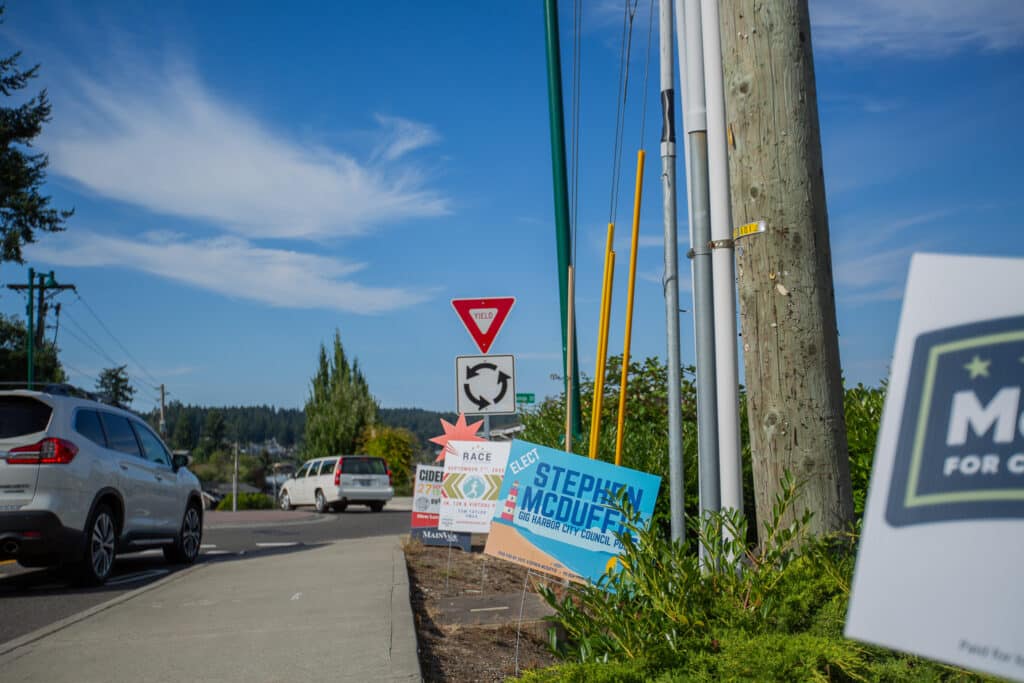Business Community Government
City considers updating sign code to include all signs, not just commercial ones
Signs proliferate around Gig Harbor every year. They sprinkle the grass of roundabouts, cluster near stop lights, and line both private property and public streets.
Of course, these signs don’t just appear by magic. People put them there — and, as it turns out, some of this sign placement isn’t entirely legal.
The city’s current code specifies, for instance, that temporary signs — like political or commercial signs — “are prohibited from being placed within: roundabouts; medians; shoulders; travel lanes; and areas of the public right-of-way that are not accessible by a sidewalk or pedestrian walking path.”
Is it a sign?
But even though this is clear in current code, other areas of the city’s sign code can be ambiguous — including what exactly qualifies as a “sign.” A recent independent review by the city’s legal team found the current language unclear and confusing. That prompted the city to consider updating its sign code.
“The new federal court cases and a legal review showed that code of our language can be viewed as ambiguous or contrary to some of those past practices, past council direction, and past community interest,” explained Community Development Director Eric Baker at a July 31 City Council study session. “This has been an issue that has grown in significance over the last three years.”

Cars pass by signs lining Stinson Avenue leading to the roundabout at Stinson Avenue and Rosedale Street on Aug. 23, 2025. Photo by Carolyn Bick. © Carolyn Bick
Baker pointed to a recent, real-world example of why the sign code needs updating.
He said that the city did a “sign sweep” of all commercial signage on July 25. They left political signs untouched, because the current code doesn’t cover political signs. But this could leave the city open to legal liability, because though the code covers the areas the city may regulate signs, it leaves out the kinds of signs the city may regulate.
“If no changes were made to the sign code,” Baker explained, “our legal staff would have concerns if we went and started enforcing upon signage both in the right-of-way and on private property if they were not commercially direct.”
A broader sign code
As it stands, the code is exacting in its language, and identifies for regulation “everything from banners to the wavy guys to just those large hanging signs that tend to kind of lean out into the right-of-way,” Baker said.
The updated language is distinctly broader and encompasses any indicator meant to promote a person, concept, or thing “using graphics, lights, symbols and/or written copy.”
This updated language is meant to leave no room for doubt that things like political signs are considered signs.
“We’re trying to capture everything that we’re trying to cover on this,” Baker explained.
The existing code specifies dimensions and heights at which temporary signs may be displayed. Because the new language encompasses banners and flags that are not state or country flags, this means that these other kinds of signs would normally be subject to the code’s existing height requirements.
The existing height limitations for residential signage is six feet from the ground, and three feet from the ground for nonresidential signage.
Go team
However, because “a number of folks like to hang their … Seahawks or Husky or Cougar flags during the college football season,” Baker said, the new language includes an exemption where, if a flag is flying from a legally established flagpole, it can be displayed above the code’s maximum height for both residential and nonresidential areas.
The code still contains language governing how many temporary signs are allowed in one area.
The update also amends what areas are included in temporary signage regulation. The code currently only references public right-of-ways as places where temporary signs could be regulated. The updated language would include private property, which is how the language has historically been applied, anyway.
“The changes that you see before you are really just acknowledging the existing code and past practice,” Baker said, “so we have enforced the code that pretty much applied to all of these types of signs for years.”
The city plans to do a full review of any possible updates to the sign code at the beginning of 2026. Gig Harbor residents who see a sign that may not be permitted under the current law can submit requests for code compliance checks here.

